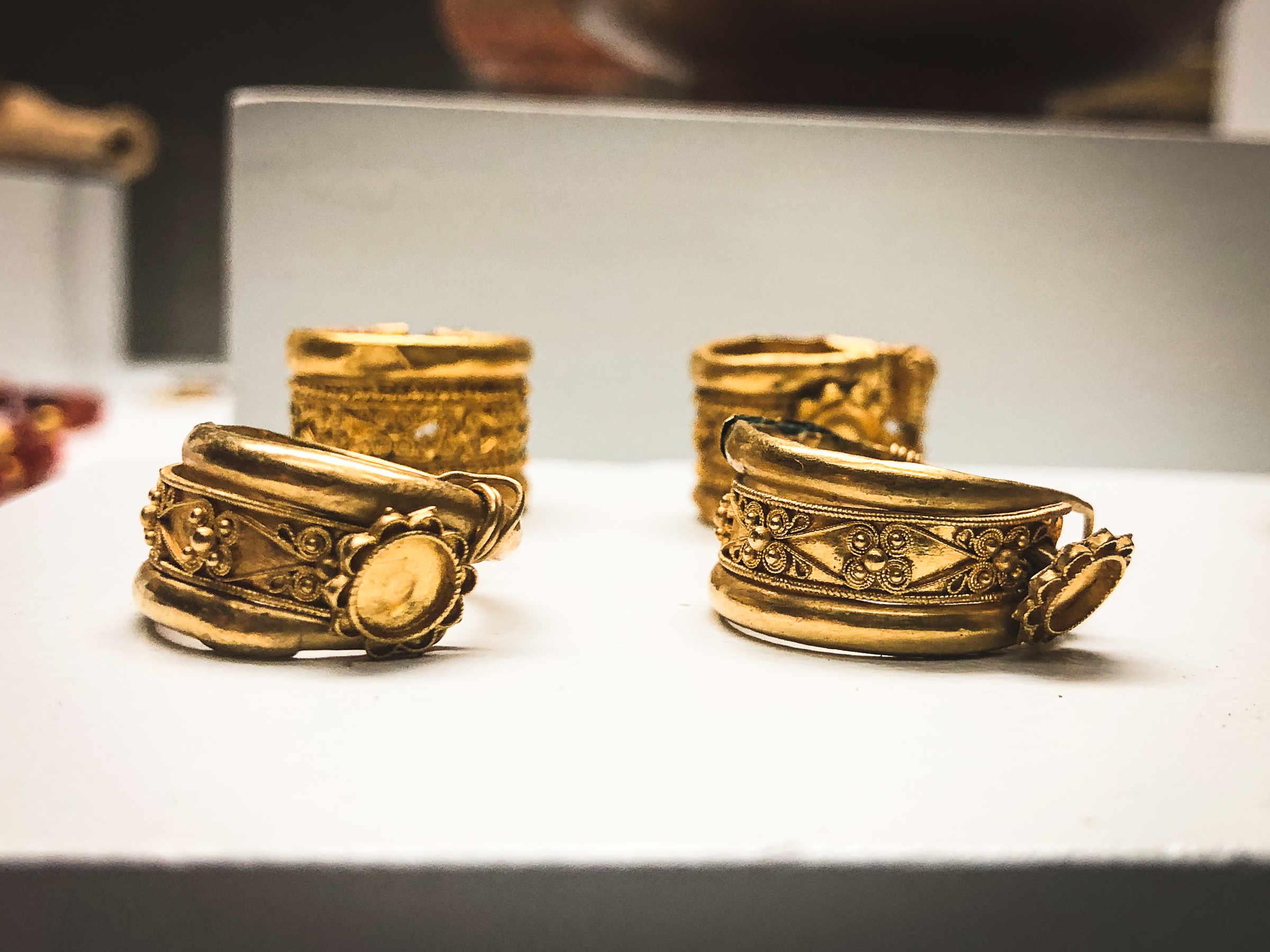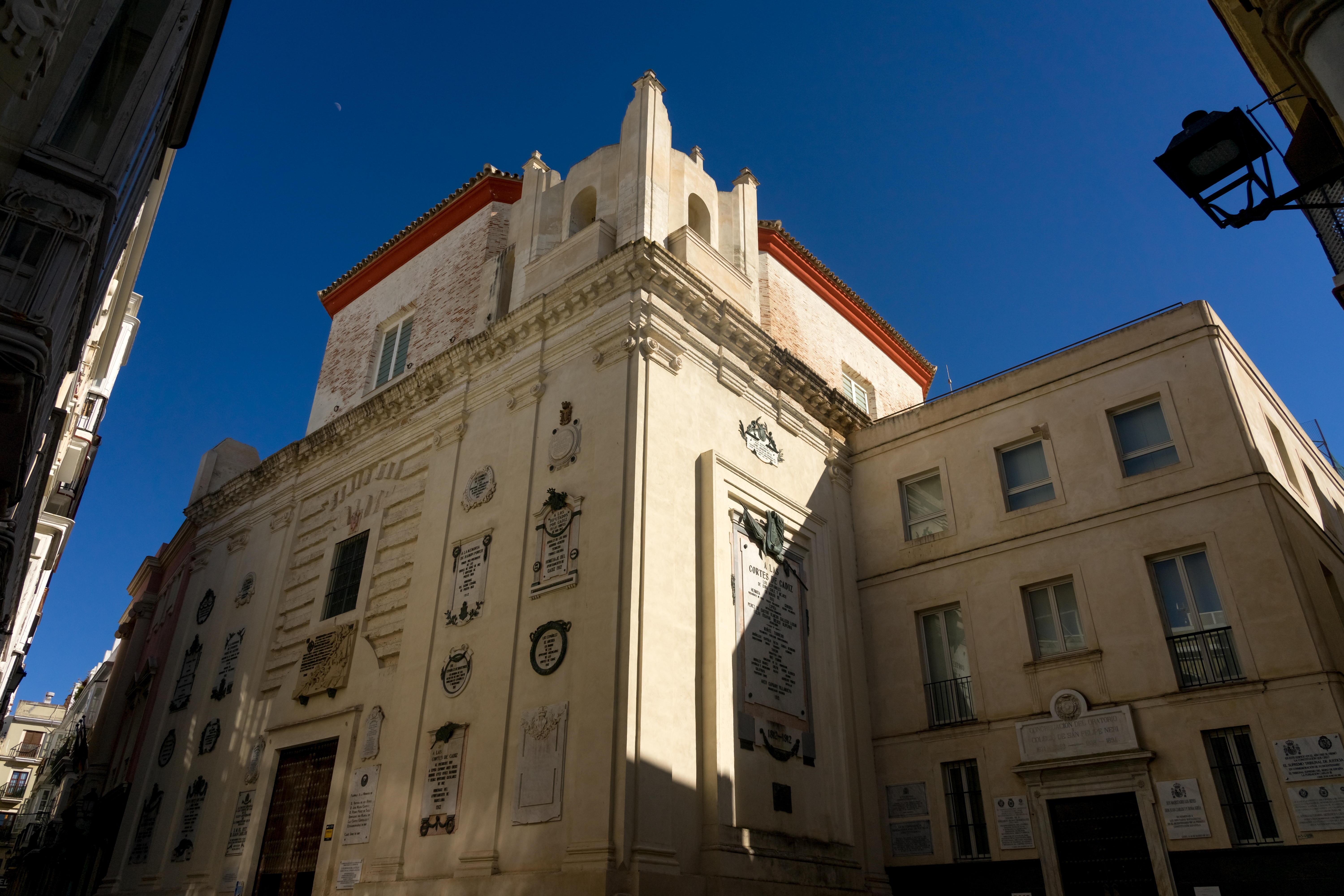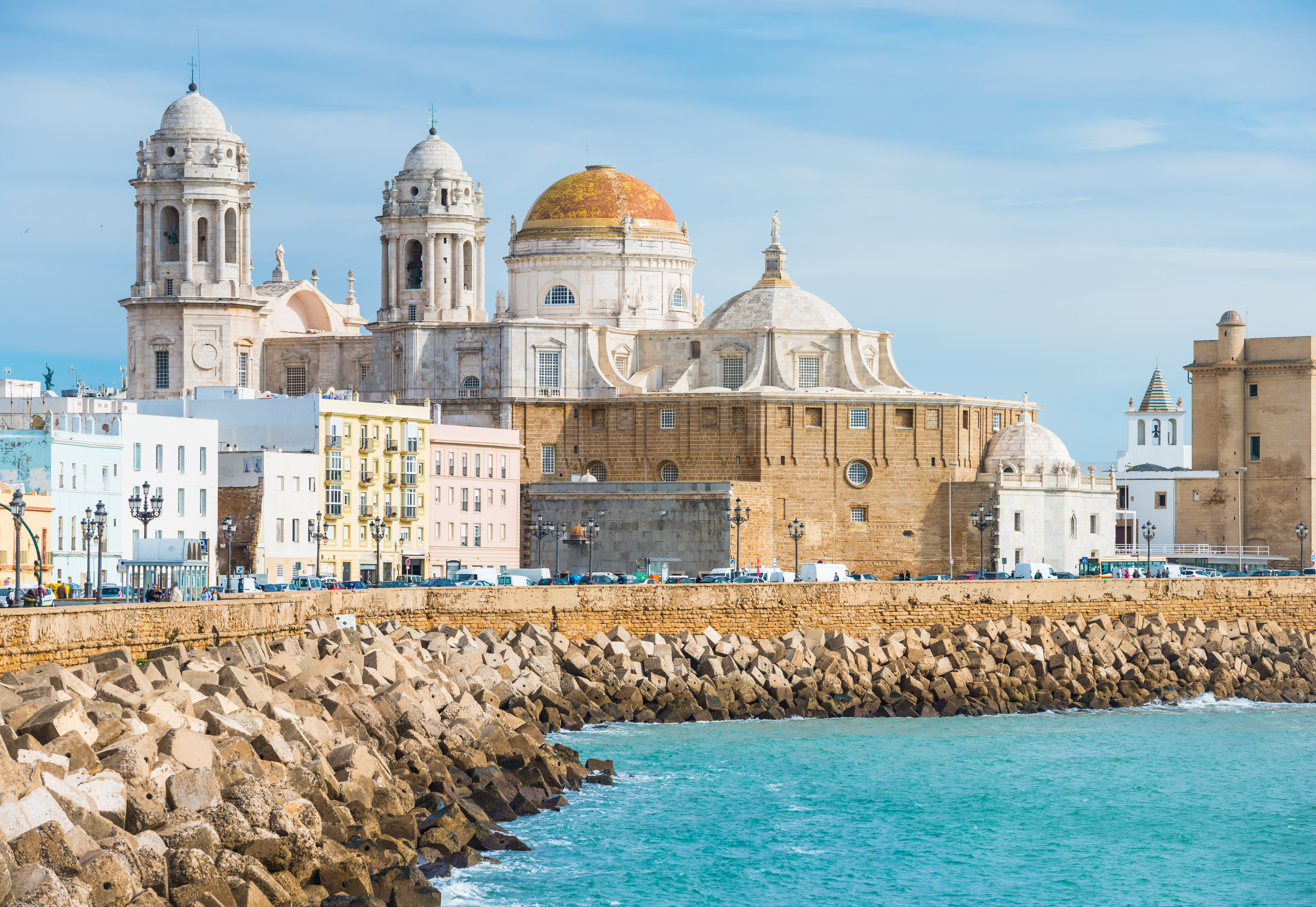Why Visit Now: Cádiz
Cádiz is the oldest continuously inhabited city in Europe – its history goes back 3,000 years to the Phoenicians, traders from the eastern Mediterranean.
Today you can see intriguing traces of previous civilizations and also immerse yourself in the city’s famous carnival – even if you can’t experience this vibrant event in person, a great new museum conveys its color, creativity, and vibrancy. Add tropical gardens, superb seafood, beautiful beaches, and the fabulously anarchic gaditanos themselves, and you’ve got another Andalucian winner. Tip: start off your visit at the excellent tourist information office, a pretty circular building on Paseo de Canalejas, next to the port.
1. Get Gadir
 Phoenicians settled in southern Spain after 800 BCE, as these golden rings exhibited in the Cádiz Museum testify. [Photo: Fiona Flores Watson]
Phoenicians settled in southern Spain after 800 BCE, as these golden rings exhibited in the Cádiz Museum testify. [Photo: Fiona Flores Watson]As with many Andalusian cities, in Cádiz, history is buried right under your feet – you can see Phoenician streets, houses and even kitchens complete with ovens, pots and animal bones in the superb Gadir archaeological site (Yacimiento Arqueologico Gadir). The remains are brought to life by augmented reality, which reconstructs the dwellings as used at the time.
The ancient maritime settlers from Phoenicia, present-day Lebanon, inhabited the Cádiz coast, trading precious metals for local wine and olive oil, for around six centuries, from the 9th to 3rd BC. Afterwards, walk to the Cueva del Pajaro Azul – Puerto de Gadir near the cathedral, a subterranean chamber which doubles as an atmospheric flamenco venue.
You can make out the Phoenician port’s dry dock, excavated from the rock, which was only discovered recently. Lastly, head to the Cádiz Museum, on Plaza Mina, to see extraordinary Phoenician jewelry and sarcophagi, as well as mosaics by the Romans who succeeded as rulers of the city.
2. Market forces
In any city, a great way to get a feel for the place, the people, and the food, is the local mercado de abastos (food market). In Cádiz, the experience is even richer, thanks to the plethora of stalls in the Mercado Central de Cádiz in Barrio San Julian, which will fulfill the gamut of gastronomic cravings – from sherry (made locally, including across the bay in neighboring town El Puerto de Santa Maria) to pescaito frito (fried fish), sushi and cured meats such as jamón ibérico.
The seafood in this area is rightly famous – look out for street stalls selling paper cones filled with tiny, tasty camarones (minuscule shrimp), used to make the famous, and utterly delicious, tortillitas de camarones. These round shrimp fritters are a Cádiz specialty, and are heavenly when paired with a glass of crisp, chilled fino or manzanilla sherry. Another marine delight is sea urchins – these pink, spiky creatures have a strong, salty flavor.
Mercado Central de Cadiz

1
A bustling array of tiny shrimp for sale, showcasing the diverse seafood selection at the historic Central Market of Cádiz. [Photo: Irina Wilhauk]

2
Lively scenes from the oldest covered market in Spain, where locals and tourists alike gather for food and drinks under the Cádiz sun. [Photo: Shutterstock]

3
Vibrant salmon steaks and a variety of fresh fish displayed on ice, a testament to the rich maritime culture of Cádiz. [Photo: Shutterstock]
3. Urban oases

Cádiz was the main port of the Americas after the River Guadalquivir silted up in the early 18th century, resulting in the transfer of the Casa de Contratación (House of Commerce) from Seville and a short-lived trade monopoly. As a result, the city’s parks and plazas host a range of blooming tropical plants – in spring, you can see flowering floss-silk trees, magnolia and jacaranda.
Be sure to visit the majestic Plaza Mina, the jungly Plaza Candelaria, and triangular Plaza Topete, home to flower stalls, and long, narrow Parque Genovés (pictured) which hugs the stretch of sea between Castillo de Santa Catalina and Baluarte de la Candelaria. There you will stumble across unusual specimens such as drago trees, red-flowered pohutukawa, gingko, and the mighty ombu. [Photo: Shutterstock]

4. Historic strolls
For those who prefer not to amble gently, but rather to follow a themed path where you will gain a good insight into one aspect of the city, you have four routes to choose from. The shortest route is number 1, Medieval District and Land Gate, which takes you into Barrio del Populo, home of the Roman Theatre, and flamenco quarter Santa Maria, ending at the main gate into the city.
 Built in the late 17th century as part of the sea wall, the Baluarte de la Candelaria defended Cádiz from pirates and invaders. [Photo: Shutterstock]
Built in the late 17th century as part of the sea wall, the Baluarte de la Candelaria defended Cádiz from pirates and invaders. [Photo: Shutterstock]Route 2, the longest, Castles and Bastions, takes you around the edge of old Cádiz, visiting all the mighty defensive structures built to fortify the coastal city – surrounded by water on three sides – from pirates and invaders. On route 3, Shippers to the Indies, you can see the most important buildings connected to 17th and 18th century New World trade, the city’s Golden Age. Finally, learn about the Cádiz Constitution (see 8, below), a decisive moment in the history of Cádiz, and Spain, on route 4.
5. Carnaval!
Cádiz is most famous – within Spain, at least – for its carnival. Held around Shrove Tuesday (February/early March), this 10-day event isn’t simply about amazing costumes. Dating from the 16th century, the Carnaval de Cádiz offers humorous, incisive commentary on topical issues – from politics to famosos (celebrities) – in satirical songs performed by groups of singers including chirigotas. Dressed up in superbly designed costumes which relate to their song, they sing witty ditties in the streets, and compete in the official competition in the Teatro Falla.
___

1
A colorful float adorned with whimsical characters parades through the Carnaval, showcasing the creative spirit of Cádiz's biggest festivity. [Photo: Jose Carrasco]

2
Vibrant colors and jubilant crowds fill the streets of Cadiz during the annual Carnaval, one of the most awaited events in the city, where satirical performances take center stage. [Photo: Shutterstock]
Anyone can join in the street party – grab a wig, hat and/or crazy glasses from a vendor and become part of the revelry in Barrio La Viña. A new interpretation center, Casa de Carnaval, opened recently, next to Torre Tavira, with ample information and videos (only in Spanish, sadly) explaining the history of this raucous and culturally significant celebration. Best of all, you can see the costumes up close – their workmanship and detailing are extraordinary.
6. Tower power
To keep a close eye on the seas around the city, torres miradores (watchtowers) were built, offering a useful aerial perspective for 18th-century merchants who could watch their ships arrive loaded with valuable merchandise such as coffee, sugar, and tobacco.

Of the 160 towers, 133 remain today, mostly in the center and north-east of the city; each merchant had their own flag, which was visible to the ships.
Learn about these fascinating structures by visiting Torre Tavira, the official watchtower of Cádiz at the city’s highest point of 45 meters. [Photo: Nadezhda Bolotina]
Situated close to the Mercado Central, the tower formed part of the Marquis of Recaño Palace, and houses explanations (in English) about the history of the square-shaped towers, along with their various styles. At the top, as well as superb views, there’s a camara oscura where you can see a projected moving image of what’s happening outside.

7. Made in Cádiz
If you’re looking to take a little piece of Cádiz magic home with you from your trip, here are a few suggestions. El Chicuco, on Plaza San Juan, is an ultramarino, a food store which sells dried, tinned and bottled foods, as well as household goods. In this case, typical local products such as sherry vinegar, extra virgin olive oil, cured meats, sheep’s cheese, Sherry wines, and high-quality fish conserves such as almadraba tuna; it also serves tapas.
For crafts, try Casa Lamar, near the top of Calle Valverde – a new lifestyle store set up by a designer-photographer couple. Among their pleasing mix of pretty pieces in natural materials by local artisans – desirable homeware, simple, elegant sustainable cotton clothes, and colorful artworks – look out for the gorgeous ceramics, photo-print silk scarves, as stocked by Liberty of London, rustic wicker basket-bags, and quirky lamps. More off-the-wall is Cadi Cadi, packed with T-shirts books, posters and maps showing classic gaditano attitude in their cheeky slogans.
 Casa Lamar, a recently opened lifestyle store brimming with design items made by local artisans. [Photo: Casa Lamar]
Casa Lamar, a recently opened lifestyle store brimming with design items made by local artisans. [Photo: Casa Lamar]8. La Pepa
In 1812, when Napoleon’s troops were occupying Spain (his brother, Joseph, was installed as puppet king) during the Peninsula War, Spain’s Cortes Generales (national legislative assembly), which had rejected Joseph, took refuge in Cádiz. The 300-odd members, both Spanish and from overseas territories, wrote a liberal constitution for Spain – the country’s first – enshrining the rights of Spanish citizens, and limiting the monarchy’s power.
Published on 19 March 1812, Dia San Jose, and hence known as La Pepa (Pepe is a nickname for Jose), it was used as a blueprint for constitutions in Portugal and several New World republics, founded by Cortes members. You can visit the then-seat of the Cortes, Oratorio San Felipe Neri church, which houses a visitor center about the Constitution of Cádiz in an annex.
 Oratorio San Felipe Neri is the historic site where the Constitution of Cádiz was signed, now featuring a visitor center in an annex dedicated to this pivotal moment in Spanish history. [Photo: Shutterstock]
Oratorio San Felipe Neri is the historic site where the Constitution of Cádiz was signed, now featuring a visitor center in an annex dedicated to this pivotal moment in Spanish history. [Photo: Shutterstock]9. Eat and beach
As already mentioned, Cádiz is famous throughout Andalucia, and beyond, for its fabulous gastronomy, especially fish and seafood.

El Faro in La Viña (the fishermen’s quarter, in the south-west corner) is a Cádiz classic: think sea urchin with shrimp tartar or brioche of roast tomato and mackerel. [Photo: Carlos Pereira M]
La Casapuerta de Luisa is an informal, buzzy neighborhood joint with tasty plates and an impressive beer selection, halfway up Calle Sagasta. For sherry, head to Taberna La Manzanilla, near Plaza Candelaria. Moving down to the beach, chiringitos (beach bars) are the place for lunch and early evening drinks – try the Russian salad with garlic prawn carpaccio or squid ink croquetas at Tirabuzon, on Playa de Santa Maria del Mar.
For sunset drinks, head to La Quilla on west-facing La Caleta beach, which doubled for Cuba in the James Bond movie, Die Another Day (remember Halle Berry striding out of the sea?).

10. Baroque views
 The sunkissed Cathedral de la Santa Cruz in Cádiz, as seen from the ocean. [Photo: Shutterstock]
The sunkissed Cathedral de la Santa Cruz in Cádiz, as seen from the ocean. [Photo: Shutterstock]Get the best sea views from the eastern Torre de Reloj (clock tower) of the baroque Cathedral de la Santa Cruz, built between the 18th and 19th centuries on the seafront. You’re surrounded by six church bells chiming every 15 minutes, as you look down onto its iconic golden-yellow dome, gleaming in the sun, along with the city’s other churches, located by signs next to each bell, and the Atlantic to the south, west, and north, where the port lies.
In the main interior space, look out for Ecce Hombre, a statue by La Roldana, in the chapel of San Sebastian. Don’t miss the intriguing circular crypt with flat ceiling, which houses the simple tomb of gaditanos composer Manuel de Falla, friend and collaborator of Lorca and contemporary of Ravel and Debussy.
